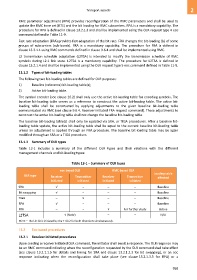Page 969 - 5G Basics - Core Network Aspects
P. 969
Transport aspects 2
RMC parameter adjustment (RPA) provides reconfiguration of the RMC parameters and shall be used to
update the RMC tone set (RTS) and the bit loading for RMC subcarriers. RPA is a mandatory capability. The
procedure for RPA is defined in clause 13.2.1.3 and shall be implemented using the OLR request type 4 eoc
command defined in Table 11-9.
Fast rate adaptation (FRA) provides fast adaptation of the bit rate. FRA changes the bit-loading (bi) of some
groups of subcarriers (sub-bands). FRA is a mandatory capability. The procedure for FRA is defined in
clause 13.3.1.1 using RMC commands defined in clause 9.6.4 and shall be implemented using RMC.
L2 transmission schedule adaptation (L2TSA) is intended to modify the transmission schedule of RMC
symbols during L2.1 link state. L2TSA is a mandatory capability. The procedure for L2TSA is defined in
clause 13.2.1.4 and shall be implemented using the OLR request type 5 eoc command defined in Table 11-9.
13.1.2 Types of bit-loading tables
The following two bit-loading tables are defined for OLR purposes:
1) Baseline (reference) bit-loading table(s);
2) Active bit-loading table.
The symbol encoder (see clause 10.2) shall only use the active bit-loading table for encoding symbols. The
baseline bit-loading table serves as a reference to construct the active bit-loading table. The active bit-
loading table shall be constructed by applying adjustments to the given baseline bit-loading table
communicated via RMC (see clause 9.6.4, Receiver initiated FRA request command). These adjustments to
construct the active bit-loading table shall not change the baseline bit-loading table.
The baseline bit-loading table(s) shall only be updated via SRA, or TIGA procedures. After a baseline bit-
loading table update, the active bit-loading table shall be equal to the current baseline bit-loading table
unless an adjustment is applied through an FRA procedure. The baseline bit-loading table may be again
modified through an SRA or a TIGA procedure.
13.1.3 Summary of OLR types
Table 13-1 includes a summary of the different OLR types and their relations with the different
management channels and bit-loading types:
Table 13-1 – Summary of OLR types
eoc-based OLR RMC-based OLR
OLR type Receiver Transmitter Receiver Transmitter Loading table
affected
initiated initiated initiated initiated
SRA √ – – – Baseline
Bit swapping √ – – – Baseline
TIGA – √ – – Baseline
RPA √ – – – Baseline
FRA – – √ For further study Active
L2TSA √ (Note) – – N/A
NOTE – The L2TSA is initiated by the FTU-O for both directions simultaneously.
13.2 Eoc-based procedures
13.2.1 Receiver initiated procedures
Upon sending a receiver initiated OLR command, the initiator shall await a response. The OLR response may
be an RMC command indicating when the reconfiguration requested by the OLR command shall take effect
(see clause 13.2.1.1.5 for details and timing for SRA and clause 13.2.1.2.3 for bit swapping), or an eoc
response indicating when the reconfiguration shall take place (see clause 13.2.1.3.3 for RPA) or a
959

